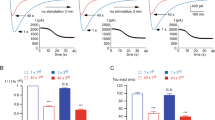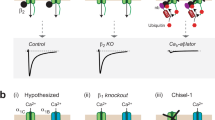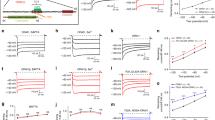Abstract
Phosphatidylinositol 3-kinase (PI3K) has been shown to enhance native voltage-dependent calcium channel (Cav) currents both in myocytes and in neurons; however, the mechanism(s) responsible for this regulation were not known. Here we show that PI3K promotes the translocation of GFP-tagged Cav channels to the plasma membrane in both COS-7 cells and neurons. We show that the effect of PI3K is mediated by Akt/PKB and specifically requires Cavβ2 subunits. The mutations S574A and S574E in Cavβ2a prevented and mimicked, respectively, the effect of PI3K/Akt-PKB, indicating that phosphorylation of Ser574 on Cavβ2a is necessary and sufficient to promote Cav channel trafficking.
This is a preview of subscription content, access via your institution
Access options
Subscribe to this journal
Receive 12 print issues and online access
$209.00 per year
only $17.42 per issue
Buy this article
- Purchase on Springer Link
- Instant access to full article PDF
Prices may be subject to local taxes which are calculated during checkout








Similar content being viewed by others
References
Catterall, W.A. Structure and regulation of voltage-gated Ca2+ channels. Annu. Rev. Cell Dev. Biol. 16, 521–555 (2000).
Dolphin, A.C. Assembly and targeting of voltage-dependent calcium channels. in Receptor and Ion Channel Trafficking (eds. Moss, S.J. & Henley, J.) 58–86 (Oxford Univ. Press, Oxford, 2002).
Viard, P. et al. Gβγ dimers stimulate vascular L-type Ca2+ channels via phosphoinositide 3-kinase. FASEB J. 13, 685–694 (1999).
Blair, L.A. & Marshall, J. IGF-1 modulates N- and L-type calcium channels in a PI 3 kinase-dependent manner. Neuron 19, 421–429 (1997).
Rameh, L.E. and Cantley, L.C. The role of phosphoinositide 3-kinase lipid products in cell function. J. Biol. Chem. 274, 8347–8350 (1999).
Andjelkovic, M. et al. Role of translocation in the activation and function of protein kinase B. J. Biol. Chem. 272, 31515–31524 (1997).
Vanhaesebroeck, B. et al. Synthesis and function of 3-phosphorylated inositol lipids. Annu. Rev. Biochem. 70, 535–602 (2001).
Rodriguez-Viciana, P. et al. Phosphatidylinositol-3-OH kinase as a direct target of Ras. Nature 370, 527–532 (1994).
Pacold, M.E. et al. Crystal structure and functional analysis of Ras binding to its effector phosphoinositide 3-kinase γ. Cell 103, 931–943 (2000).
Kurosu, H. et al. Heterodimeric phosphoinositide 3-kinase consisting of p85 and p110β is synergistically activated by the βγ subunits of G proteins and phosphotyrosyl peptide. J. Biol. Chem. 272, 24252–24256 (1997).
Murga, C., Laguinge, L., Wetzker, R., Cuadrado, A. & Gutkind, J.S. Activation of Akt/protein kinase B by G protein–coupled receptors. A role for α and βγ subunits of heterotrimeric G proteins acting through phosphatidylinositol-3-OH kinase gamma. J. Biol. Chem. 273, 19080–19085 (1998).
Maier, U., Babich, A. & Nürnberg, B. Roles of non-catalytic subunits in Gβγ-induced activation of class I phosphoinositide 3-kinase β and γ. J. Biol. Chem. 274, 29311–29317 (1999).
Stephens, G.J., Brice, N.L., Berrow, N.S. & Dolphin, A.C. Facilitation of rabbit α1B calcium channels: involvement of endogenous Gβγ subunits. J. Physiol. (Lond.) 509, 15–27 (1998).
Lopez-llasaca, M.L., Crespo, P., Pellici, P.G., Gutkind, J.S. & Wetzker, R. Linkage of G protein–coupled receptors to the MAPK signaling pathway through PI 3-kinase γ. Science 275, 394–397 (1997).
Gray, A., Van Der Kaay, J. & Downes, C.P. The pleckstrin homology domains of protein kinase B and GRP1 (general receptor for phosphoinositides-1) are sensitive and selective probes for the cellular detection of phosphatidylinositol 3,4-bisphosphate and/or phosphatidylinositol 3,4,5-trisphosphate in vivo. Biochem. J. 344, 29–36 (1999).
Bondeva, T. et al. Bifurcation of lipid and protein kinase signals of PI3Kγ to the protein kinases PKB and MAPK. Science 282, 293–296 (1998).
Chien, A.J., Carr, K.M., Shirokov, R.E., Rios, E. & Hosey, M.M. Identification of palmitoylation sites within the L-type calcium channel β2a subunit and effects on channel function. J. Biol. Chem. 271, 26465–26468 (1996).
Stephens, G.J., Page, K.M., Bogdanov, Y. & Dolphin, A.C. The α1B Ca2+ channel amino terminus contributes determinants for β subunit-mediated voltage-dependent inactivation properties. J. Physiol. (Lond.) 525, 377–390 (2000).
Brice, N.L. et al. Importance of the different β-subunits in the membrane expression of the α1A and α2 calcium channel subunits: studies using a depolarisation-sensitive α1A antibody. Eur. J. Neurosci. 9, 749–759 (1997).
Chien, A.J. et al. Roles of a membrane-localized β subunit in the formation and targeting of functional L-type Ca2+ channels. J. Biol. Chem. 270, 30036–30044 (1995).
Kanzaki, M. et al. Translocation of a calcium-permeable cation channel induced by insulin-like growth factor-1. Nat. Cell Biol. 1, 165–170 (1999).
Raghib, A. et al. Dominant-negative synthesis suppression of voltage-gated calcium channel Cav2.2 induced by truncated constructs. J. Neurosci. 21, 8495–8504 (2001).
Wang, Q. et al. Protein kinase B/Akt participates in GLUT4 translocation by insulin in L6 myoblasts. Mol. Cell. Biol. 19, 4008–4018 (1999).
Bertrand, L. et al. Heart 6-phosphofructo-2-kinase activation by insulin results from Ser-466 and Ser-483 phosphorylation and requires 3-phosphoinositide-dependent kinase-1, but not protein kinase B. J. Biol. Chem. 274, 30927–30933 (1999).
Obata, T. et al. Peptide and protein library screening defines optimal substrate motifs for Akt/PKB. J. Biol. Chem. 275, 36108–36115 (2000).
Martin, D.J. et al. Gabapentin-mediated inhibition of voltage-activated Ca2+ channel currents in cultured sensory neurones is dependent on culture conditions and channel subunit expression. Neuropharmacology 42, 353–366 (2002).
Wu, L., Bauer, C.S., Zhen, X.G., Xie, C. & Yang, J. Dual regulation of voltage-gated calcium channels by PtdIns(4,5)P2 . Nature 419, 947–952 (2002).
Lhuillier, L. & Dryer, S.E. Developmental regulation of neuronal KCa channels by GFβ1: an essential role for PI3 kinase signaling and membrane insertion. J. Neurophysiol. 88, 954–964 (2002).
Insall, R.H. & Weiner, O.D. PIP3, PIP2, and cell movement—Similar messages, different meanings? Dev. Cell 1, 743–747 (2001).
Girard, C. et al. p11, an annexin II subunit, an auxiliary protein associated with the background K+ channel, TASK-1. EMBO J. 21, 4439–4448 (2002).
Rajan, S. et al. Interaction with 14-3-3 proteins promotes functional expression of the potassium channels TASK-1 and TASK-3. J. Physiol. (Lond.) 545, 13–26 (2002).
O'Kelly, I., Butler, M.H., Zilberberg, N. & Goldstein, S.A. Forward transport. 14-3-3 binding overcomes retention in endoplasmic reticulum by dibasic signals. Cell 111, 577–588 (2002).
Bichet, D. et al. The I–II loop of the Ca2+ channel α1 subunit contains an endoplasmic reticulum retention signal antagonized by the β subunit. Neuron 25, 177–190 (2000).
Pichler, M. et al. β subunit heterogeneity in neuronal L-type Ca2+ channels. J. Biol. Chem. 272, 13877–13882 (1997).
Scott, V.E.S. et al. β subunit heterogeneity in N-type Ca2+ channels. J. Biol. Chem. 271, 3207–3212 (1996).
Yano, S., Tokumitsu, H. & Soderling, T.R. Calcium promotes cell survival through CaM-K Kinase activation of the protein-kinase-B pathway. Nature 396, 584–587 (1998).
Blair, L.A. et al. Akt-dependent potentiation of L channels by insulin-like growth factor-1 is required for neuronal survival. J. Neurosci. 19, 1940–1951 (1999).
Lie, A.A. et al. Distribution of voltage-dependent calcium channel β subunits in the hippocampus of patients with temporal lobe epilepsy. Neuroscience 93, 449–456.
Brock, C. et al. Roles of Gβγ in membrane recruitment and activation of p110γ/p101 phosphoinositide 3-kinase γ. J. Cell Biol. 160, 89–99 (2003).
Acknowledgements
We thank K. Chaggar, W.S. Pratt, J. Wratten and M. Nieto-Rostro for technical assistance and K. Page, A. Babich and N.S. Berrow for discussions. This work was supported by the Wellcome Trust and Medical Research Council (UK).
Author information
Authors and Affiliations
Corresponding author
Ethics declarations
Competing interests
The authors declare no competing financial interests.
Supplementary information
Supplementary Fig. 1
Nuclear staining with Hoechst 33342 of PHGrp1-GFP-labeled control and PI3Kγ-transfected cells. Subcellular localization of PHGrp1-GFP in control (a) and PI3Kγ-transfected cells (b). First panel: subcellular localization of PHGrp1-GFP. The intensity profiles below the image was taken at the position indicated by the red bar. Second panel: nucleus staining with Hoechst 33342. Third panel: overlay of the PHGrp1-GFP fluorescence image and nuclear staining. Scale bars: 10 μm (JPG 96 kb)
Supplementary Fig. 2
Effect of PI3Kγ and myr-Akt/PKB co-transfection on Cav2.2α1 subcellular localization. To ensure that the maximal PI3K effect was obtained, we used the membrane-targeted PI3Kγ-CAAX (p101-p110γ-CAAX), constitutively localized at the proximity of its lipid substrate39. (a) Subcellular distribution of PHGrp1-GFP in cells co-transfected with PI3Kγ-CAAX. The amount of PIP3–binding domain was increased at the plasma membrane. The arrowhead indicates lamellipodia which are generally associated with high lipid kinase activity. (b) Effect of PI3Kγ-CAAX and myr-Akt/PKB co-expression on the subcellular localization of GFP-Cav2.2α1/β2a channel. Profiles showing the fluorescence intensity along the line indicated in red are displayed below each cell. Scale bars: 10 μm. (c) Upper panel: example traces of Cav2.2α1/β2a IBa recorded in control and PI3Kγ-CAAX plus myr-Akt/PKB-co-transfected cells. Vertical and horizontal scales are 20 pA/pF and 100 ms, respectively. Lower panel: mean I-V relationship of Cav2.2α1/β2a channels in control (○) or PI3Kγ-CAAX and myr-Akt/PKB-co-transfected cells (●). Results are expressed as mean ± s.e.m of 7 cells each. (JPG 70 kb)
Both the localization of Cav2.2/β2a channels at the plasma membrane (b) and Cav2.2/ β2a IBa (c) were increased by simultaneous expression of myr-Akt/PKB and PI3Kγ-CAAX.
Supplementary Fig. 3
Immunodetection of total cell Cav2.2α1 in control and PI3Kγ-CAAX- plus myr-Akt/PKB-transfected cells. (a) Immunodetection of total cell Cav2.2 α 1 (arrowhead) in un-transfected, control and PI3Kγ-CAAX- plus myr-Akt/PKB-transfected cells. (b) Quantification of the relative amounts of total cell Cav2.2 α 1 co-expressed in control (open bars) and PI3Kγ-CAAX plus myr-Akt/PKB-transfected cells (closed bars). (JPG 19 kb)
Supplementary Fig. 4
Alignment of Cavβ C-terminus sequences. Identification of a unique putative consensus site for phosphorylation by Akt/PKB on Cavβ2a subunit, absent in Cavβ1b, Cavβ3 and Cavβ4 subunits. C-terminus sequences of Cavβ1b, Cavβ2a, Cavβ3, Cavβ4 and both Cavβ2aS574A and Cavβ2aS574E mutants. (GIF 28 kb)
Supplementary Video 1
Z-stack showing the membrane localization of GFP-Cav2.2α1/β2a channels in a PI3Kγ-transfected cell. In cells transfected with PI3Kγ, the strong plasma membrane localization of GFP-Cav2.2α1/β2a channels was visible independently of the focal plane of acquisition. (MOV 2349 kb)
Supplementary Video 2
Z-stack showing the membrane localization of GFP-Cav2.2α1/β2aS574E channels. The strong plasma membrane localization of GFP-Cav2.2α1/β2aS574E channels was visible independently of the focal plane of acquisition. (MOV 1813 kb)
Rights and permissions
About this article
Cite this article
Viard, P., Butcher, A., Halet, G. et al. PI3K promotes voltage-dependent calcium channel trafficking to the plasma membrane. Nat Neurosci 7, 939–946 (2004). https://doi.org/10.1038/nn1300
Received:
Accepted:
Published:
Issue Date:
DOI: https://doi.org/10.1038/nn1300
This article is cited by
-
Molecular mechanism of hyperactivation conferred by a truncation of TRPA1
Nature Communications (2023)
-
Cellular and molecular effects of hyperglycemia on ion channels in vascular smooth muscle
Cellular and Molecular Life Sciences (2021)
-
Identification of Novel Inhibitors of DLK Palmitoylation and Signaling by High Content Screening
Scientific Reports (2019)
-
1,25-Dihydroxyvitamin D modulates L-type voltage-gated calcium channels in a subset of neurons in the developing mouse prefrontal cortex
Translational Psychiatry (2019)
-
System Biology Approach to Identify Potential Receptor for Targeting Cancer and Biomolecular Interaction Studies of Indole[2,1-a]Isoquinoline Derivative as Anticancerous Drug Candidate Against it
Interdisciplinary Sciences: Computational Life Sciences (2019)



